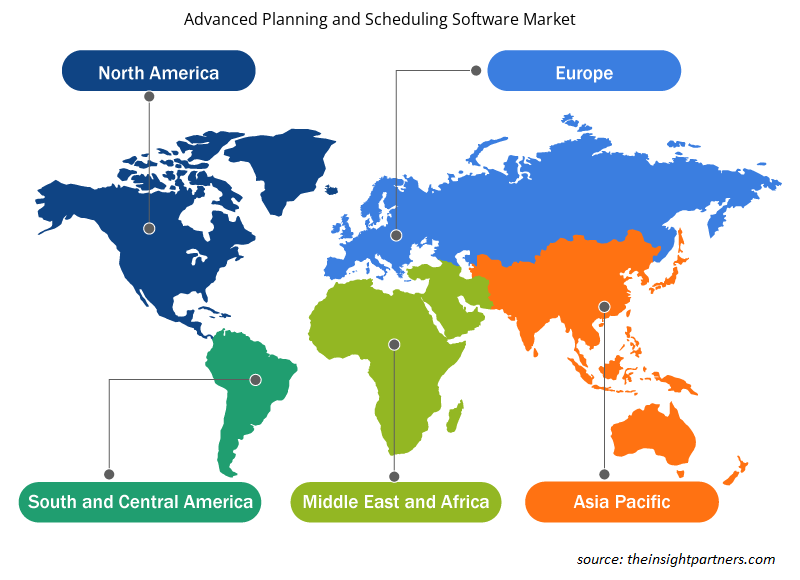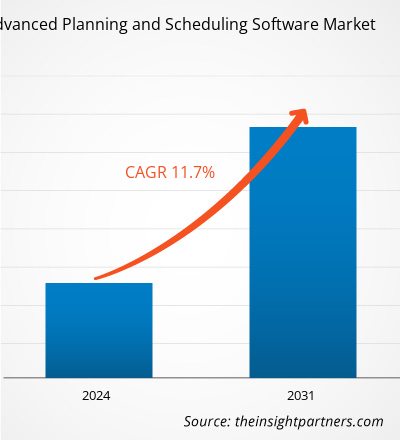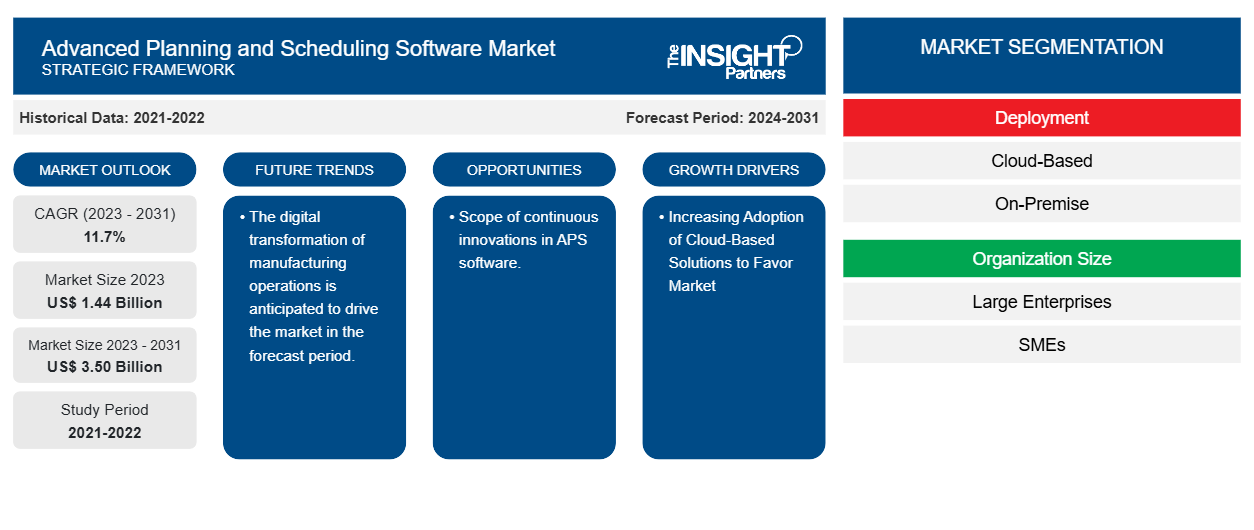Le marché des logiciels de planification et d’ordonnancement avancés devrait atteindre 3,50 milliards de dollars d’ici 2031, contre 1,44 milliard de dollars en 2023. Le marché devrait enregistrer un TCAC de 11,7 % au cours de la période 2023-2031. Le besoin croissant d’améliorer le processus de production global et l’adoption croissante de solutions basées sur le cloud devraient rester des tendances et des moteurs clés du marché.
Analyse du marché des logiciels de planification et d'ordonnancement avancés
Le marché des logiciels de planification et d’ordonnancement avancés connaît une croissance significative à l’échelle mondiale. Cette croissance est attribuée au besoin croissant d’améliorer le processus de production global et à l’adoption croissante de solutions basées sur le cloud. De plus, la portée croissante des innovations continues dans les logiciels APS et la transformation numérique des opérations de fabrication devraient offrir plusieurs opportunités au marché dans les années à venir.
Aperçu du marché des logiciels de planification et d'ordonnancement avancés
Advanced Planning and Scheduling (APS) est une solution qui aide les fabricants à contrôler la planification de la production et l'ordonnancement des ateliers. En utilisant des algorithmes avancés pour équilibrer la demande et la capacité et produire des calendriers de production réalisables, les logiciels de planification et d'ordonnancement avancés permettent d'accélérer les délais de livraison pour répondre aux demandes des clients et de répondre plus facilement et plus rapidement aux changements de production imprévus.
Personnalisez ce rapport en fonction de vos besoins
Vous bénéficierez d'une personnalisation gratuite de n'importe quel rapport, y compris de certaines parties de ce rapport, d'une analyse au niveau des pays, d'un pack de données Excel, ainsi que d'offres et de remises exceptionnelles pour les start-ups et les universités.
- Obtenez les principales tendances clés du marché de ce rapport.Cet échantillon GRATUIT comprendra une analyse de données, allant des tendances du marché aux estimations et prévisions.
Moteurs et opportunités du marché des logiciels de planification et d'ordonnancement avancés
Adoption croissante de solutions basées sur le cloud pour favoriser le marché.
L'adoption croissante de solutions basées sur le cloud stimule en effet la croissance du marché des logiciels de planification et d'ordonnancement avancés. Le système de planification et d'ordonnancement avancé basé sur le cloud (CAPS) est basé sur une planification et une ordonnancement dynamiques intelligents (IDPS), qui se compose de cinq modules principaux, notamment l'entrée, la simulation, la planification de la capacité (CP), l'analyse d'impact sur la capacité (CIA) et la sortie. De plus, les solutions APS basées sur le cloud consomment peu d'investissements directs par rapport aux solutions sur site. Cela augmente la demande de logiciels de planification et d'ordonnancement avancés des organisations, y compris des PME. Ainsi, compte tenu des paramètres ci-dessus, l'adoption croissante de solutions basées sur le cloud stimule la croissance du marché des logiciels de planification et d'ordonnancement avancés.
Portée des innovations continues dans les logiciels APS.
La portée des innovations continues dans les logiciels APS offre des opportunités importantes pour le marché. Les innovations continues peuvent conduire à l'intégration d'algorithmes adaptatifs avec des systèmes tels que les ERP , les MES et les appareils IoT. Elles améliorent également l'expérience utilisateur et les interfaces intuitives en devenant plus conviviales, en réduisant la courbe d'apprentissage et en augmentant les taux d'adoption parmi les utilisateurs non techniques. Les logiciels APS présentent également des avantages tels que la personnalisation et la flexibilité, l'analyse prédictive, l'apprentissage automatique, les solutions basées sur le cloud et l'accès mobile. Ainsi, compte tenu des facteurs ci-dessus, la portée des innovations continues dans les logiciels APS devrait stimuler le marché des logiciels de planification et d'ordonnancement avancés.
Analyse de segmentation du rapport sur le marché des logiciels de planification et d'ordonnancement avancés
Les segments clés qui ont contribué à l’élaboration de l’analyse du marché des logiciels de planification et d’ordonnancement avancés sont le déploiement, la taille de l’organisation et le secteur d’activité.
- En fonction du déploiement, le marché des logiciels de planification et d'ordonnancement avancés est divisé en deux catégories : basé sur le cloud et sur site. Le segment des composants de gestion de l'alimentation devrait détenir une part de marché importante au cours de la période de prévision.
- En fonction de la taille de l'organisation, le marché des logiciels de planification et d'ordonnancement avancés est divisé en grandes entreprises et en PME. Le segment des grandes entreprises devrait détenir une part de marché importante au cours de la période de prévision.
- Le marché est segmenté en secteurs industriels : fabrication, produits pharmaceutiques et sciences de la vie, vente au détail et biens de consommation, alimentation et boissons, produits chimiques, automobile, aérospatiale et défense, électronique, etc. Le secteur manufacturier devrait détenir une part de marché importante au cours de la période de prévision.
Analyse des parts de marché des logiciels avancés de planification et d'ordonnancement par zone géographique
La portée géographique du rapport sur le marché des logiciels de planification et d’ordonnancement avancés est principalement divisée en cinq régions : Amérique du Nord, Asie-Pacifique, Europe, Moyen-Orient et Afrique, et Amérique du Sud et centrale.
L'Amérique du Nord domine le marché des logiciels de planification et d'ordonnancement avancés. Le marché nord-américain est segmenté en États-Unis, Canada et Mexique. Les tendances d'adoption de haute technologie dans diverses industries de la région nord-américaine ont alimenté la croissance du marché des logiciels de planification et d'ordonnancement avancés. Des facteurs tels que la mise en œuvre accrue d'outils numériques et les dépenses technologiques élevées des agences gouvernementales devraient stimuler la croissance du marché nord-américain des logiciels de planification et d'ordonnancement avancés. De plus, l'accent mis sur la recherche et le développement dans les économies développées des États-Unis et du Canada oblige les acteurs nord-américains à apporter des solutions technologiquement avancées sur le marché. En outre, les États-Unis comptent un grand nombre d'acteurs du marché des logiciels de planification et d'ordonnancement avancés qui se concentrent progressivement sur le développement de solutions innovantes. Tous ces facteurs contribuent à la croissance du marché des logiciels de planification et d'ordonnancement avancés de la région.
Aperçu régional du marché des logiciels de planification et d'ordonnancement avancés
Les tendances et facteurs régionaux influençant le marché des logiciels de planification et d’ordonnancement avancés tout au long de la période de prévision ont été expliqués en détail par les analystes d’Insight Partners. Cette section traite également des segments et de la géographie du marché des logiciels de planification et d’ordonnancement avancés en Amérique du Nord, en Europe, en Asie-Pacifique, au Moyen-Orient et en Afrique, ainsi qu’en Amérique du Sud et en Amérique centrale.

- Obtenez les données régionales spécifiques au marché des logiciels de planification et d'ordonnancement avancés
Portée du rapport sur le marché des logiciels de planification et d'ordonnancement avancés
| Attribut de rapport | Détails |
|---|---|
| Taille du marché en 2023 | 1,44 milliard de dollars américains |
| Taille du marché d'ici 2031 | 3,50 milliards de dollars américains |
| Taux de croissance annuel composé mondial (2023-2031) | 11,7% |
| Données historiques | 2021-2022 |
| Période de prévision | 2024-2031 |
| Segments couverts | Par déploiement
|
| Régions et pays couverts | Amérique du Nord
|
| Leaders du marché et profils d'entreprises clés |
|
Densité des acteurs du marché des logiciels de planification et d'ordonnancement avancés : comprendre son impact sur la dynamique des entreprises
Le marché des logiciels de planification et d'ordonnancement avancés connaît une croissance rapide, tirée par la demande croissante des utilisateurs finaux en raison de facteurs tels que l'évolution des préférences des consommateurs, les avancées technologiques et une plus grande sensibilisation aux avantages du produit. À mesure que la demande augmente, les entreprises élargissent leurs offres, innovent pour répondre aux besoins des consommateurs et capitalisent sur les tendances émergentes, ce qui alimente davantage la croissance du marché.
La densité des acteurs du marché fait référence à la répartition des entreprises ou des sociétés opérant sur un marché ou un secteur particulier. Elle indique le nombre de concurrents (acteurs du marché) présents sur un marché donné par rapport à sa taille ou à sa valeur marchande totale.
Les principales entreprises opérant sur le marché des logiciels de planification et d'ordonnancement avancés sont :
- ACUMATICA, INC
- SOCIÉTÉ ASPROVA
- Cybertec
- Dassault Systèmes SE
- DELFOI OY
- SOLUTIONS DE MAGASIN GLOBALES
Avis de non-responsabilité : les sociétés répertoriées ci-dessus ne sont pas classées dans un ordre particulier.

- Obtenez un aperçu des principaux acteurs du marché des logiciels de planification et d'ordonnancement avancés
Actualités et développements récents du marché des logiciels de planification et d'ordonnancement avancés
Le marché des logiciels de planification et d'ordonnancement avancés est évalué en collectant des données qualitatives et quantitatives après des recherches primaires et secondaires, qui incluent d'importantes publications d'entreprise, des données d'association et des bases de données. Quelques-uns des développements du marché des logiciels de planification et d'ordonnancement avancés sont répertoriés ci-dessous :
- Cosmo Tech a lancé une bibliothèque de connecteurs APS dédiée aux logiciels de planification et d'ordonnancement avancés. La bibliothèque de connecteurs APS de Cosmo Tech propose plusieurs connecteurs prédéfinis et la possibilité de s'intégrer à des solutions de planification de la chaîne d'approvisionnement populaires telles que SAP IBP, Blue Yonder, Kinaxis et OMP. (Source : site Web de la société Cosmo Tech, juin 2024)
- Amtech Software, basée à Fort Washington, en Pennsylvanie, a annoncé le lancement d'Advanced Planning Board (APB), la dernière innovation qui s'intègre parfaitement dans Encore ERP. APB est une solution Web qui utilise un algorithme de points flexibles pour automatiser la fonction de planification, permettant aux planificateurs d'usine de gérer facilement les articles à passes multiples et à pièces multiples. (Source : Amtech Software, site Web de l'entreprise, avril 2024)
Rapport sur le marché des logiciels de planification et d'ordonnancement avancés et livrables
Le rapport « Taille et prévisions du marché des logiciels de planification et d’ordonnancement avancés (2021-2031) » fournit une analyse détaillée du marché couvrant les domaines ci-dessous :
- Taille et prévisions du marché des logiciels de planification et de programmation avancés aux niveaux mondial, régional et national pour tous les segments de marché clés couverts dans le cadre.
- Tendances du marché des logiciels de planification et d’ordonnancement avancés ainsi que dynamique du marché telles que les moteurs, les contraintes et les opportunités clés.
- Analyse détaillée des cinq forces de PEST/Porter et SWOT.
- Analyse du marché des logiciels de planification et d’ordonnancement avancés couvrant les principales tendances du marché, le cadre mondial et régional, les principaux acteurs, les réglementations et les développements récents du marché.
- Analyse du paysage industriel et de la concurrence couvrant la concentration du marché, l'analyse de la carte thermique, les principaux acteurs et les développements récents pour le marché des logiciels de planification et de programmation avancés.
- Profils d'entreprise détaillés.
- Analyse historique (2 ans), année de base, prévision (7 ans) avec TCAC
- Analyse PEST et SWOT
- Taille du marché Valeur / Volume - Mondial, Régional, Pays
- Industrie et paysage concurrentiel
- Ensemble de données Excel
Rapports récents
Rapports connexes
Témoignages
Raison d'acheter
- Prise de décision éclairée
- Compréhension de la dynamique du marché
- Analyse concurrentielle
- Connaissances clients
- Prévisions de marché
- Atténuation des risques
- Planification stratégique
- Justification des investissements
- Identification des marchés émergents
- Amélioration des stratégies marketing
- Amélioration de l'efficacité opérationnelle
- Alignement sur les tendances réglementaires





















 Obtenez un échantillon gratuit pour - Marché des logiciels avancés de planification et d'ordonnancement
Obtenez un échantillon gratuit pour - Marché des logiciels avancés de planification et d'ordonnancement